#170: Hapalopilus nidulans
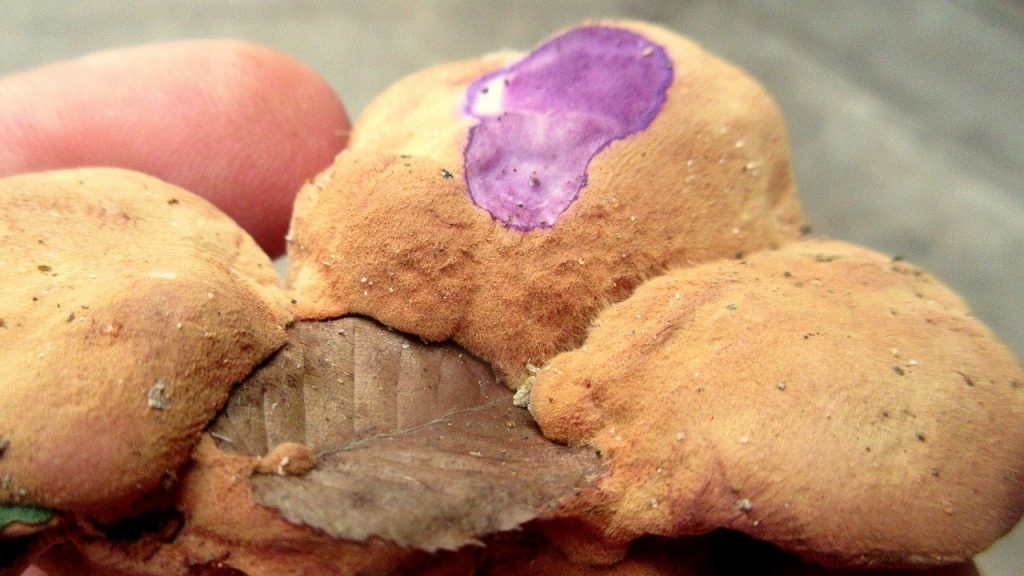
Hapalopilus nidulans is a humdrum polypore until you apply KOH or ammonia. Do that and it turns purple! Photo by Judy T. [CC BY-SA 3.0], via Mushroom Observer (cropped)
Description
H. nidulans is a bracket or shelf fungus, meaning it grows directly out of its substrate with no stipe. This means the mushrooms are generally semicircular to kidney-shaped, depending on the shape of the surface upon which they are growing.1 The mushroom grows up to 12cm across and 4cm thick, making it a small to medium-sized mushroom. On top, it features an orangish to light brown or cinnamon surface that is covered in small hairs at first but becomes smooth with time.1–3 Underneath, H. nidulans produces small pores with flattened edges (“angular pores”) that are colored like the pileus.1,2
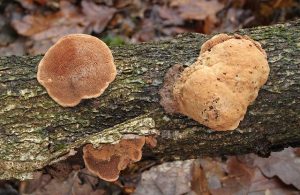
Hapalopilus nidulans from below (left side of image) and above (right side of image). Photo by H. Krisp [CC BY 3.0], via Wikimedia Commons
Ecology
H. nidulans is a white rotter that decomposes “coarse woody debris” (logs and sticks). This mushroom usually grows on the wood of hardwoods, but sometimes appears on conifer wood.1 You can find H. nidulans in North America and Europe from spring through fall and sometimes during winter in warmer regions. Unfortunately, the mushroom is not common in any part of its range.1,2 Within North America, H. nidulans is most common east of the Rocky Mountains but it occasionally appears in the Pacific Northwest and the Southwest. In southwestern North America, the mushroom is usually found on conifer debris, which differs from its normal habitat in the rest of the world.1
Toxicity
Most people consider polypores a basically harmless group. However, there are many exceptions to that generalization (and you should certainly never eat anything you have not identified to species, even if it is a polypore). One of the most significant exceptions is H. nidulans, which contains the toxin polyporic acid.4 Polyporic acid (IUPAC name: 2,5-dihydroxy-3,6-diphenylcyclohexa-2,5-diene-1,4-dione) is a small molecule composed of three carbon rings.5 This molecule is probably responsible for the color change in H. nidulans.4

Structure of Polyporic Acid. Public domain image via Wikimedia Commons
Symptoms of H. nidulans poisoning include: gastrointestinal distress, blurry vision, inability to balance, loss of kidney function, and purple urine. These symptoms can persist for a few days, but usually clear up within a week.6 Studies in mice show that polyporic acid is capable of causing damage to the stomach and kidneys as well as upsetting the balance of chemicals in the blood. Polyporic acid seems to cause these effects by inhibiting the action of dihydroorotate dehydrogenase, which is important in RNA synthesis.4
There are other polypores that contain polyporic acid, but H. nidulans is the most dangerous. Polyporic acid can account for as much as 40% of the mushroom’s dry weight. Consequently, even the small fruiting bodies of H. nidulans can be dangerous.4
There are many small, brownish polypores that you could confuse with H. nidulans, but most of these are not worth eating. Some of the cases of H. nidulans poisoning happened because someone mistook H. nidulans for the Beefsteak Fungus (Fistulina hepatica, FFF#165).6 These two mushrooms are theoretically easy to tell apart based on their descriptions. Pay special attention to the pore surface, which has small angular pores in H. nidulans but in F. hepatica is bumpy or composed of individual pore tubes.
Use in Dyeing
The distinguishing feature of H. nidulans is that it turns purple when a basic solution is applied. People working with dyes extracted from mushrooms found that the purple color works very well as a dye for wool.4 To use this mushroom for dyeing, break it up into small pieces and place it in hot water with pre-mordanted wool. Then use ammonia to adjust the pH up to 9. The ammonia turns the mushroom purple. That color leaves the mushroom and adheres to the wool, turning it anywhere from a deep purple to a bright lavender. You normally use a 1:1 dry weight ratio of mushroom to wool, but H. nidulans is a strong dyer and you can probably use less. This is good, since H. nidulans is a fairly uncommon mushroom.7 See FFF#159 for more on dyeing with mushrooms.
Taxonomy
H. nidulans is related to the core section of polypores, the Polyporales. Some older texts may refer to it as Polyporus nidulans. A more commonly encountered synonym for this mushroom is H. rutilans.1 The mushroom sometimes goes by the common name of the “Tender Nesting Polypore,” which is just a translation of Hapalopilus (“soft/tender pileus”) nidulans (“nesting”).3
| Kingdom | Fungi |
| Phylum | Basidiomycota |
| Subphylum | Agaricomycotina |
| Class | Agaricomycetes |
| Order | Polyporales |
| Family | Polyporaceae |
| Genus | Hapalopilus |
| Species | Hapalopilus nidulans (Fr.) P. Karst.8 |
See Further:
http://www.mushroomexpert.com/hapalopilus_nidulans.html
http://www.rogersmushrooms.com/gallery/DisplayBlock~bid~5990~gid~~source~gallerydefault.asp
http://www.messiah.edu/oakes/fungi_on_wood/poroid%20fungi/species%20pages/Hapalopilus%20nidulans.htm
Citations
- Michael Kuo. Hapalopilus nidulans. MushroomExpert.Com (2003). Available at: http://www.mushroomexpert.com/hapalopilus_nidulans.html. (Accessed: 16th December 2016)
- Roger Phillips. Hapalopilus nidulans. RogersMushrooms Available at: http://www.rogersmushrooms.com/gallery/DisplayBlock~bid~5990~gid~~source~gallerydefault.asp. (Accessed: 16th December 2016)
- Gary Emberger. Hapalopilus nidulans. Fungi Growing on Wood (2008). Available at: http://www.messiah.edu/oakes/fungi_on_wood/poroid%20fungi/species%20pages/Hapalopilus%20nidulans.htm. (Accessed: 16th December 2016)
- Michael W. Beug. Polyporic Acid in Fungi: A Brief Note. North American Mycological Association Available at: http://www.namyco.org/polyporic_acid_in_fungi.php. (Accessed: 16th December 2016)
- Pubchem. Polyporic acid. Available at: https://pubchem.ncbi.nlm.nih.gov/compound/Polyporic_acid. (Accessed: 16th December 2016)
- Villa, A. F. et al. Tender Nesting Polypore (Hapalopilus rutilans) poisoning: report of two cases. Clin Toxicol (Phila) 51, 798–800 (2013). (Retrieved from: https://www.ncbi.nlm.nih.gov/pubmed/23937526)
- Susan Hopkins. NAMA Mushroom Dyeing Workshop Sept. 8, 2016. (2016).
- Hapalopilus nidulans. Mycobank Available at: http://www.mycobank.org/MB/414438. (Accessed: 16th December 2016)

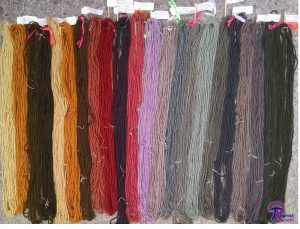

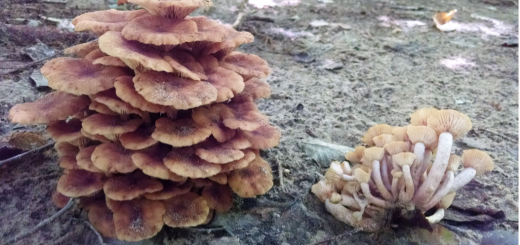





![#011: Characteristics of Kingdom Fungi [Archived]](https://www.fungusfactfriday.com/wp-content/themes/hueman/assets/front/img/thumb-small-empty.png)

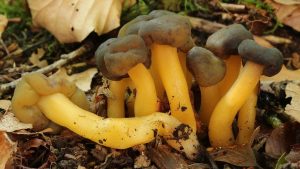
Hi all, I just want to ask if someone ever tried using shrooms or truffles for medical purposes? I was reading some articles about this magic truffles and shrooms before engaging my self for the first time. Like this one from: .They say that it has a very potent effect on the brain and hallucination. Unlike marijuana does it have any medical use? In one article that I’ve read magic truffles or shrooms compaired to synthetic drugs are very alarming https://www.trufflemagic.com/blog/shrooms-vs-acid-lsd-vs-shrooms-psychedelic-experience/. Also magic mushroom are use on reducing the symptoms of obsessive-compulsive disorder and anxiety. It can also help people to quit smoking and alcohol addiction. Some studies also suggest the property of magic shrooms/truffles can be useful for cancer patients. I would really want to hear other insights regarding this new possible alternative meds. Thanks
Psilocybin (the active chemical in magic mushrooms) is being used in limited clinical trials to alter mood and thoughts in the ways you mentioned. However, as far as I know it is not being tested for non-psychology-related medicinal uses. Studies have found it is useful for cancer patients (in a controlled and supportive environment only) because it alleviates anxiety and depression that go along with the disease. The researchers did not examine potential effects outside the brain and I’ve never heard anyone attribute other medicinal properties — such as antiviral, antibacterial, or anticancer activity — to psilocybin-containing mushrooms. Those medicinal properties are attributed to various other mushrooms and I have written about some of them under the medicinal tag.